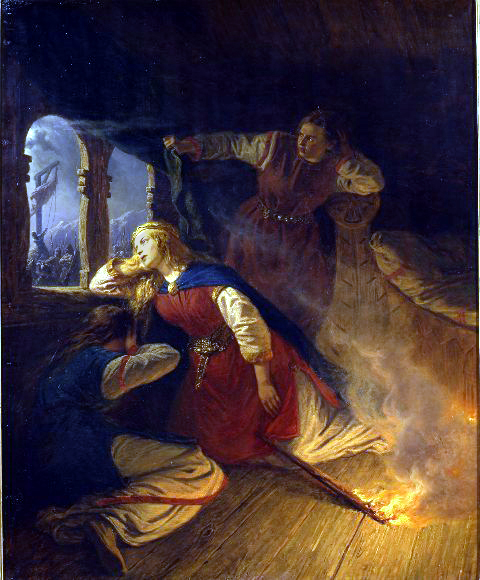Signy’s Characterization: The Saga vs. Morris’ “Story”

By Brian Conway.
William Morris’ 1867 “Story of Sigurd” reimagines the medieval Saga of the Volsungs, adapting the text to entertain his Victorian English audience. Morris takes a very direct and narrative text and embellishes it through a more lyrical tone and descriptive diction, meanwhile developing a more complex characterization for the medieval legends. This is especially evident in the transformation of Signy, who is unwillingly married to Siggeir in The Saga: “It seemed advisable to the king to betroth her, and she was promised to King Siggeir” (Saga 38). Signy knows that her marriage to Siggeir is beneficial to her family, the Volsungs, for the purpose of securing an alliance between the two kingdoms, but her motives and feeling are not entirely evident in the original text. I find it interesting that she seems to be hesitant but agreeable in marrying Siggeir; she simply asks her father his opinion and ultimately must go along with it. This questions whether Signy is a heroic figure for sacrificing her true desires for the good of her family, or if she instead is understood to be a weak woman by her relatives. There is a lack of narration or dialogue to describe Signy’s character and her motives; these deeper character traits are largely open for interpretation.
Morris, however, takes advantage of this opportunity for interpretation by characterizing Signy in a deeper, more feminist light. He describes her as “Signy the fairer then fair, Signy the wiser than wise,” and she is then portrayed as “the snow-white Signy… sat with folded hands” (Morris 2). This angelic and mighty picture of Signy is absent in the original Saga, and her discussion with her father is also described in more detail in Morris’ text. She seems happier to marry Siggeir and may have more of a say in the matter: “‘I will sleep in a great king’s bed, I will bear the lords of the earth,'” she tells her father (Morris 3). In this version, Signy’s declaration of the situation hints at a sense of control in her voice and character that she did not possess in The Saga, where she was ‘betrothed to’ Siggeir according to the narrator. As depicted above, Signy longs for this greater sense of independence in the original text as inferred by her clear unwillingness to marry Siggeir and lay with him. She gains more of this control through her characterization in Morris’ “Story of Sigurd” because she converses with her father and moreso decides alongside him to make the decision that is best for the greater good. She is more clearly a heroic, powerful, and emotional figure in this instance. Morris’ choice to expand the agency of characters by adding dialogue and descriptive language allows Signy to become more of her own person, especially in the first scenes of us as readers getting to know her in the respective texts.





